Mortgage Broking Report: Risks, Process, and Client Considerations
VerifiedAdded on 2019/11/12
|5
|1766
|151
Report
AI Summary
This report provides a comprehensive analysis of mortgage broking, addressing key aspects such as lending risks, the loan application process, and client considerations. Task A focuses on identifying and assessing systemic risks like rising interest rates, income variations, and fluctuating house prices, providing insights into their potential impact on clients. The report also explores risk mitigation strategies involving partnerships between the state, market, and borrowers, as well as the role of insurance companies. Task B delves into the mortgage process, covering pre-qualification, mortgage programs, loan applications, loan estimates, processing, required documents, credit reports, and closing disclosures. The report also includes an LVR calculation and an appendix with a detailed breakdown of fees and costs associated with purchasing a home, offering valuable information for both borrowers and industry professionals. The report emphasizes the importance of understanding the mortgage process and the associated costs to make informed financial decisions.
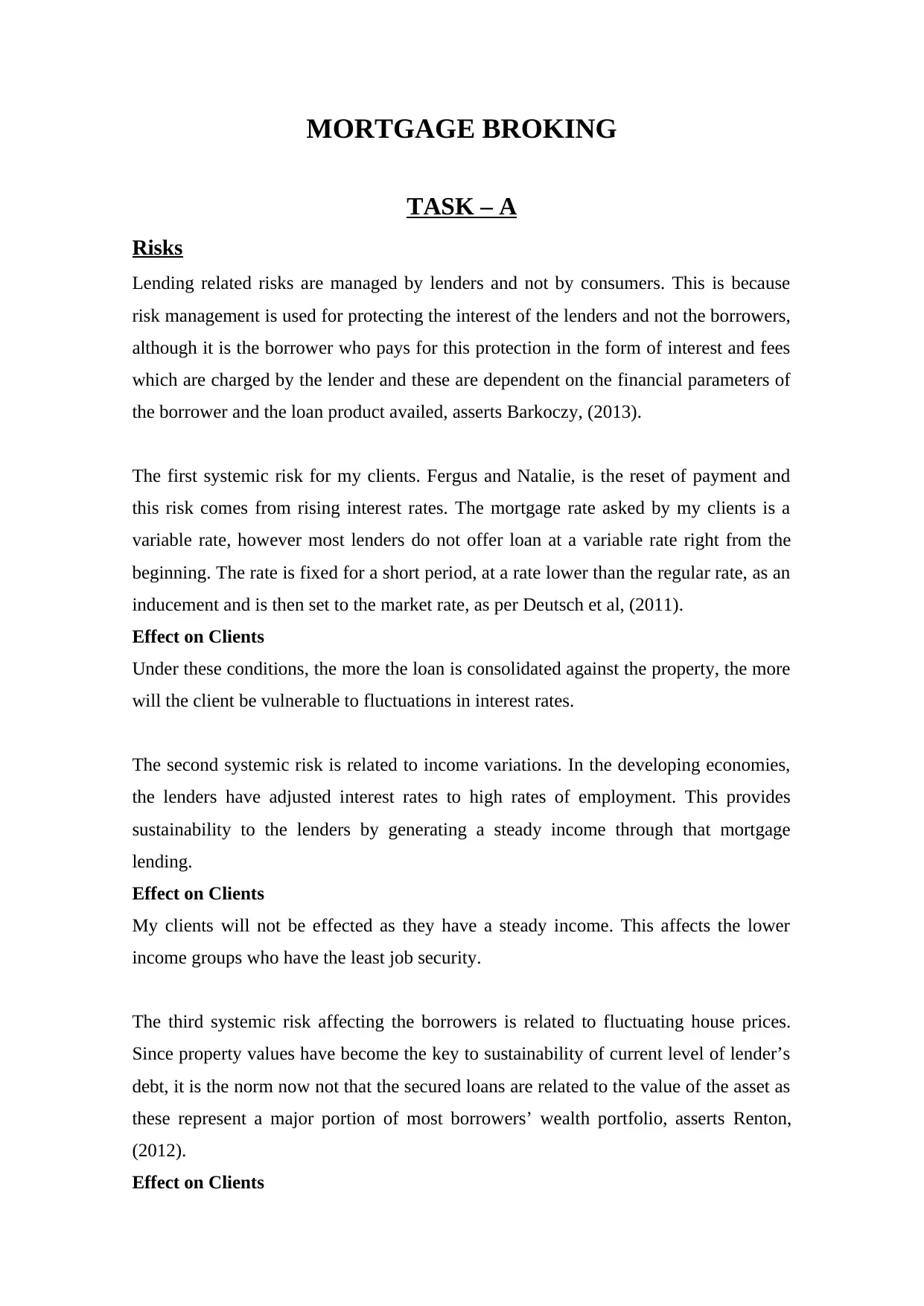
MORTGAGE BROKING
TASK – A
Risks
Lending related risks are managed by lenders and not by consumers. This is because
risk management is used for protecting the interest of the lenders and not the borrowers,
although it is the borrower who pays for this protection in the form of interest and fees
which are charged by the lender and these are dependent on the financial parameters of
the borrower and the loan product availed, asserts Barkoczy, (2013).
The first systemic risk for my clients. Fergus and Natalie, is the reset of payment and
this risk comes from rising interest rates. The mortgage rate asked by my clients is a
variable rate, however most lenders do not offer loan at a variable rate right from the
beginning. The rate is fixed for a short period, at a rate lower than the regular rate, as an
inducement and is then set to the market rate, as per Deutsch et al, (2011).
Effect on Clients
Under these conditions, the more the loan is consolidated against the property, the more
will the client be vulnerable to fluctuations in interest rates.
The second systemic risk is related to income variations. In the developing economies,
the lenders have adjusted interest rates to high rates of employment. This provides
sustainability to the lenders by generating a steady income through that mortgage
lending.
Effect on Clients
My clients will not be effected as they have a steady income. This affects the lower
income groups who have the least job security.
The third systemic risk affecting the borrowers is related to fluctuating house prices.
Since property values have become the key to sustainability of current level of lender’s
debt, it is the norm now not that the secured loans are related to the value of the asset as
these represent a major portion of most borrowers’ wealth portfolio, asserts Renton,
(2012).
Effect on Clients
TASK – A
Risks
Lending related risks are managed by lenders and not by consumers. This is because
risk management is used for protecting the interest of the lenders and not the borrowers,
although it is the borrower who pays for this protection in the form of interest and fees
which are charged by the lender and these are dependent on the financial parameters of
the borrower and the loan product availed, asserts Barkoczy, (2013).
The first systemic risk for my clients. Fergus and Natalie, is the reset of payment and
this risk comes from rising interest rates. The mortgage rate asked by my clients is a
variable rate, however most lenders do not offer loan at a variable rate right from the
beginning. The rate is fixed for a short period, at a rate lower than the regular rate, as an
inducement and is then set to the market rate, as per Deutsch et al, (2011).
Effect on Clients
Under these conditions, the more the loan is consolidated against the property, the more
will the client be vulnerable to fluctuations in interest rates.
The second systemic risk is related to income variations. In the developing economies,
the lenders have adjusted interest rates to high rates of employment. This provides
sustainability to the lenders by generating a steady income through that mortgage
lending.
Effect on Clients
My clients will not be effected as they have a steady income. This affects the lower
income groups who have the least job security.
The third systemic risk affecting the borrowers is related to fluctuating house prices.
Since property values have become the key to sustainability of current level of lender’s
debt, it is the norm now not that the secured loans are related to the value of the asset as
these represent a major portion of most borrowers’ wealth portfolio, asserts Renton,
(2012).
Effect on Clients
Paraphrase This Document
Need a fresh take? Get an instant paraphrase of this document with our AI Paraphraser
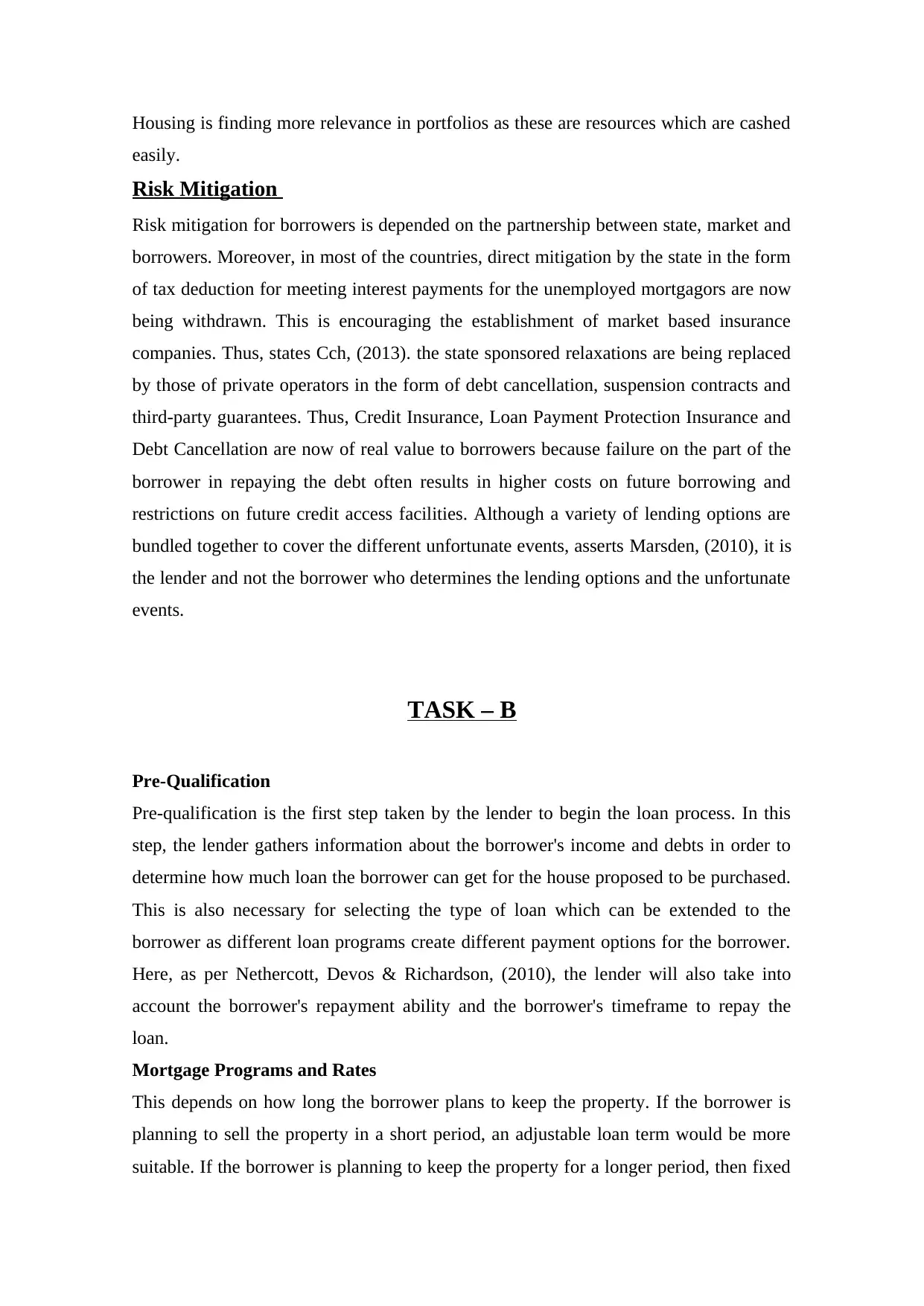
Housing is finding more relevance in portfolios as these are resources which are cashed
easily.
Risk Mitigation
Risk mitigation for borrowers is depended on the partnership between state, market and
borrowers. Moreover, in most of the countries, direct mitigation by the state in the form
of tax deduction for meeting interest payments for the unemployed mortgagors are now
being withdrawn. This is encouraging the establishment of market based insurance
companies. Thus, states Cch, (2013). the state sponsored relaxations are being replaced
by those of private operators in the form of debt cancellation, suspension contracts and
third-party guarantees. Thus, Credit Insurance, Loan Payment Protection Insurance and
Debt Cancellation are now of real value to borrowers because failure on the part of the
borrower in repaying the debt often results in higher costs on future borrowing and
restrictions on future credit access facilities. Although a variety of lending options are
bundled together to cover the different unfortunate events, asserts Marsden, (2010), it is
the lender and not the borrower who determines the lending options and the unfortunate
events.
TASK – B
Pre-Qualification
Pre-qualification is the first step taken by the lender to begin the loan process. In this
step, the lender gathers information about the borrower's income and debts in order to
determine how much loan the borrower can get for the house proposed to be purchased.
This is also necessary for selecting the type of loan which can be extended to the
borrower as different loan programs create different payment options for the borrower.
Here, as per Nethercott, Devos & Richardson, (2010), the lender will also take into
account the borrower's repayment ability and the borrower's timeframe to repay the
loan.
Mortgage Programs and Rates
This depends on how long the borrower plans to keep the property. If the borrower is
planning to sell the property in a short period, an adjustable loan term would be more
suitable. If the borrower is planning to keep the property for a longer period, then fixed
easily.
Risk Mitigation
Risk mitigation for borrowers is depended on the partnership between state, market and
borrowers. Moreover, in most of the countries, direct mitigation by the state in the form
of tax deduction for meeting interest payments for the unemployed mortgagors are now
being withdrawn. This is encouraging the establishment of market based insurance
companies. Thus, states Cch, (2013). the state sponsored relaxations are being replaced
by those of private operators in the form of debt cancellation, suspension contracts and
third-party guarantees. Thus, Credit Insurance, Loan Payment Protection Insurance and
Debt Cancellation are now of real value to borrowers because failure on the part of the
borrower in repaying the debt often results in higher costs on future borrowing and
restrictions on future credit access facilities. Although a variety of lending options are
bundled together to cover the different unfortunate events, asserts Marsden, (2010), it is
the lender and not the borrower who determines the lending options and the unfortunate
events.
TASK – B
Pre-Qualification
Pre-qualification is the first step taken by the lender to begin the loan process. In this
step, the lender gathers information about the borrower's income and debts in order to
determine how much loan the borrower can get for the house proposed to be purchased.
This is also necessary for selecting the type of loan which can be extended to the
borrower as different loan programs create different payment options for the borrower.
Here, as per Nethercott, Devos & Richardson, (2010), the lender will also take into
account the borrower's repayment ability and the borrower's timeframe to repay the
loan.
Mortgage Programs and Rates
This depends on how long the borrower plans to keep the property. If the borrower is
planning to sell the property in a short period, an adjustable loan term would be more
suitable. If the borrower is planning to keep the property for a longer period, then fixed
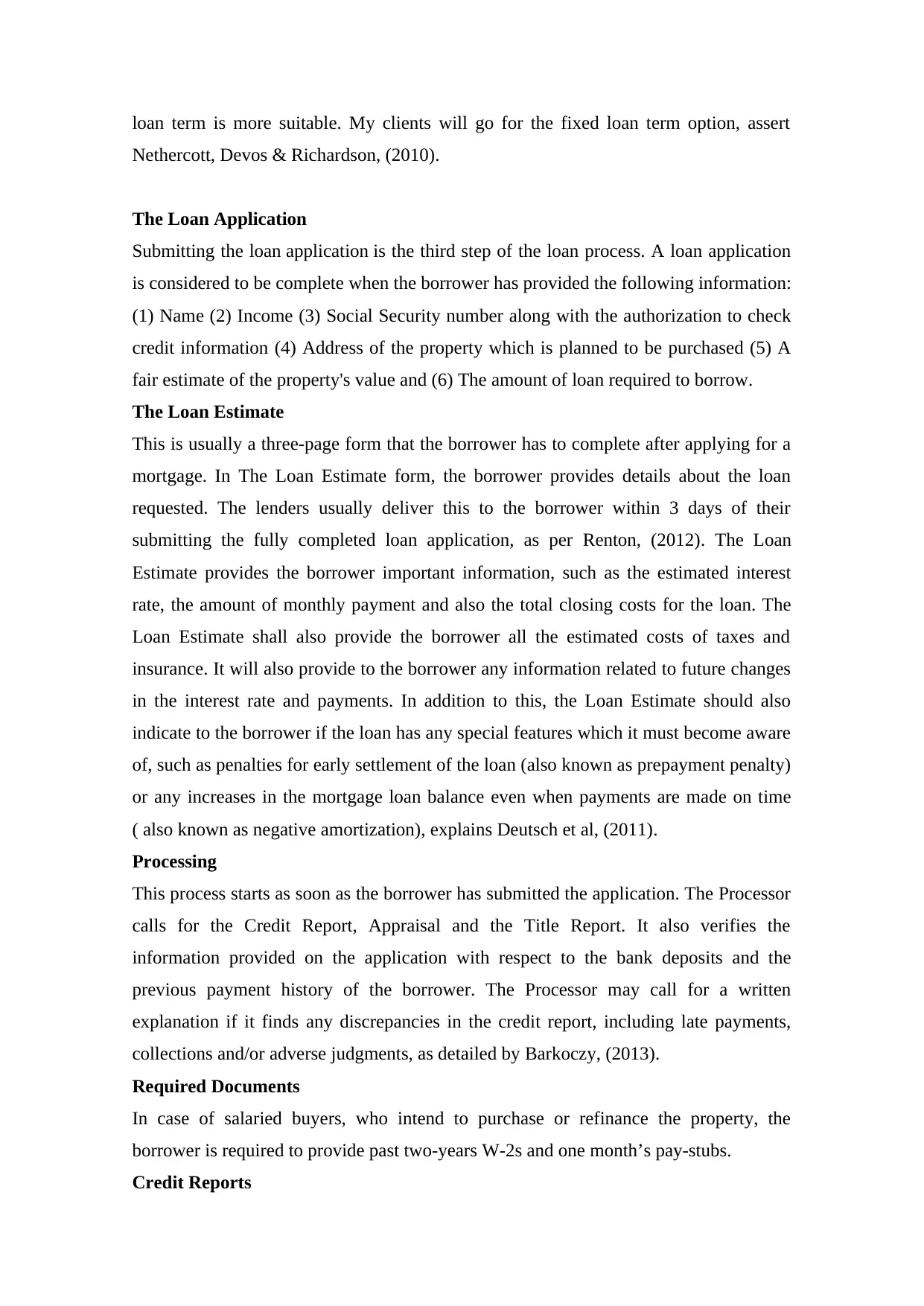
loan term is more suitable. My clients will go for the fixed loan term option, assert
Nethercott, Devos & Richardson, (2010).
The Loan Application
Submitting the loan application is the third step of the loan process. A loan application
is considered to be complete when the borrower has provided the following information:
(1) Name (2) Income (3) Social Security number along with the authorization to check
credit information (4) Address of the property which is planned to be purchased (5) A
fair estimate of the property's value and (6) The amount of loan required to borrow.
The Loan Estimate
This is usually a three-page form that the borrower has to complete after applying for a
mortgage. In The Loan Estimate form, the borrower provides details about the loan
requested. The lenders usually deliver this to the borrower within 3 days of their
submitting the fully completed loan application, as per Renton, (2012). The Loan
Estimate provides the borrower important information, such as the estimated interest
rate, the amount of monthly payment and also the total closing costs for the loan. The
Loan Estimate shall also provide the borrower all the estimated costs of taxes and
insurance. It will also provide to the borrower any information related to future changes
in the interest rate and payments. In addition to this, the Loan Estimate should also
indicate to the borrower if the loan has any special features which it must become aware
of, such as penalties for early settlement of the loan (also known as prepayment penalty)
or any increases in the mortgage loan balance even when payments are made on time
( also known as negative amortization), explains Deutsch et al, (2011).
Processing
This process starts as soon as the borrower has submitted the application. The Processor
calls for the Credit Report, Appraisal and the Title Report. It also verifies the
information provided on the application with respect to the bank deposits and the
previous payment history of the borrower. The Processor may call for a written
explanation if it finds any discrepancies in the credit report, including late payments,
collections and/or adverse judgments, as detailed by Barkoczy, (2013).
Required Documents
In case of salaried buyers, who intend to purchase or refinance the property, the
borrower is required to provide past two-years W-2s and one month’s pay-stubs.
Credit Reports
Nethercott, Devos & Richardson, (2010).
The Loan Application
Submitting the loan application is the third step of the loan process. A loan application
is considered to be complete when the borrower has provided the following information:
(1) Name (2) Income (3) Social Security number along with the authorization to check
credit information (4) Address of the property which is planned to be purchased (5) A
fair estimate of the property's value and (6) The amount of loan required to borrow.
The Loan Estimate
This is usually a three-page form that the borrower has to complete after applying for a
mortgage. In The Loan Estimate form, the borrower provides details about the loan
requested. The lenders usually deliver this to the borrower within 3 days of their
submitting the fully completed loan application, as per Renton, (2012). The Loan
Estimate provides the borrower important information, such as the estimated interest
rate, the amount of monthly payment and also the total closing costs for the loan. The
Loan Estimate shall also provide the borrower all the estimated costs of taxes and
insurance. It will also provide to the borrower any information related to future changes
in the interest rate and payments. In addition to this, the Loan Estimate should also
indicate to the borrower if the loan has any special features which it must become aware
of, such as penalties for early settlement of the loan (also known as prepayment penalty)
or any increases in the mortgage loan balance even when payments are made on time
( also known as negative amortization), explains Deutsch et al, (2011).
Processing
This process starts as soon as the borrower has submitted the application. The Processor
calls for the Credit Report, Appraisal and the Title Report. It also verifies the
information provided on the application with respect to the bank deposits and the
previous payment history of the borrower. The Processor may call for a written
explanation if it finds any discrepancies in the credit report, including late payments,
collections and/or adverse judgments, as detailed by Barkoczy, (2013).
Required Documents
In case of salaried buyers, who intend to purchase or refinance the property, the
borrower is required to provide past two-years W-2s and one month’s pay-stubs.
Credit Reports
⊘ This is a preview!⊘
Do you want full access?
Subscribe today to unlock all pages.

Trusted by 1+ million students worldwide
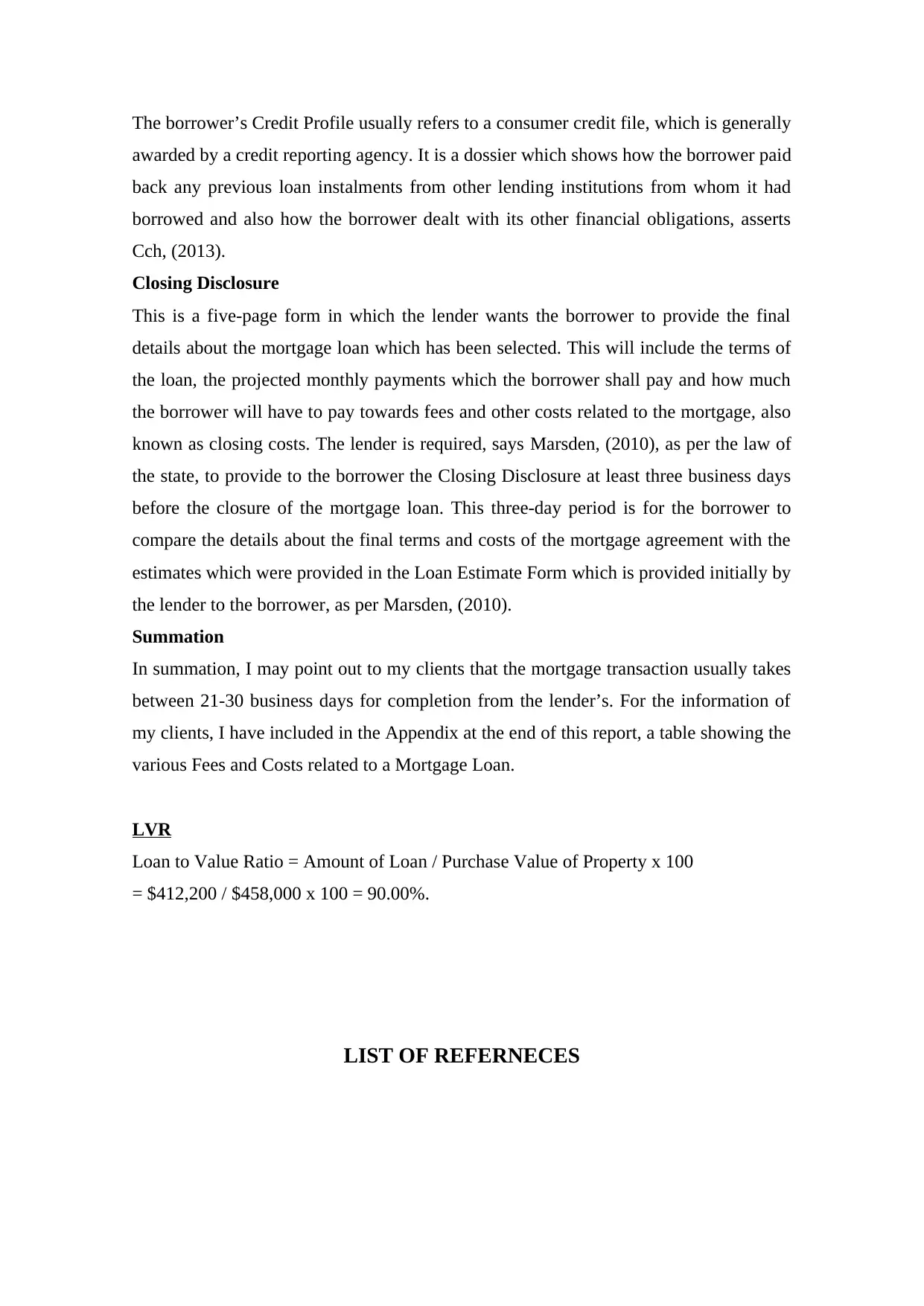
The borrower’s Credit Profile usually refers to a consumer credit file, which is generally
awarded by a credit reporting agency. It is a dossier which shows how the borrower paid
back any previous loan instalments from other lending institutions from whom it had
borrowed and also how the borrower dealt with its other financial obligations, asserts
Cch, (2013).
Closing Disclosure
This is a five-page form in which the lender wants the borrower to provide the final
details about the mortgage loan which has been selected. This will include the terms of
the loan, the projected monthly payments which the borrower shall pay and how much
the borrower will have to pay towards fees and other costs related to the mortgage, also
known as closing costs. The lender is required, says Marsden, (2010), as per the law of
the state, to provide to the borrower the Closing Disclosure at least three business days
before the closure of the mortgage loan. This three-day period is for the borrower to
compare the details about the final terms and costs of the mortgage agreement with the
estimates which were provided in the Loan Estimate Form which is provided initially by
the lender to the borrower, as per Marsden, (2010).
Summation
In summation, I may point out to my clients that the mortgage transaction usually takes
between 21-30 business days for completion from the lender’s. For the information of
my clients, I have included in the Appendix at the end of this report, a table showing the
various Fees and Costs related to a Mortgage Loan.
LVR
Loan to Value Ratio = Amount of Loan / Purchase Value of Property x 100
= $412,200 / $458,000 x 100 = 90.00%.
LIST OF REFERNECES
awarded by a credit reporting agency. It is a dossier which shows how the borrower paid
back any previous loan instalments from other lending institutions from whom it had
borrowed and also how the borrower dealt with its other financial obligations, asserts
Cch, (2013).
Closing Disclosure
This is a five-page form in which the lender wants the borrower to provide the final
details about the mortgage loan which has been selected. This will include the terms of
the loan, the projected monthly payments which the borrower shall pay and how much
the borrower will have to pay towards fees and other costs related to the mortgage, also
known as closing costs. The lender is required, says Marsden, (2010), as per the law of
the state, to provide to the borrower the Closing Disclosure at least three business days
before the closure of the mortgage loan. This three-day period is for the borrower to
compare the details about the final terms and costs of the mortgage agreement with the
estimates which were provided in the Loan Estimate Form which is provided initially by
the lender to the borrower, as per Marsden, (2010).
Summation
In summation, I may point out to my clients that the mortgage transaction usually takes
between 21-30 business days for completion from the lender’s. For the information of
my clients, I have included in the Appendix at the end of this report, a table showing the
various Fees and Costs related to a Mortgage Loan.
LVR
Loan to Value Ratio = Amount of Loan / Purchase Value of Property x 100
= $412,200 / $458,000 x 100 = 90.00%.
LIST OF REFERNECES
Paraphrase This Document
Need a fresh take? Get an instant paraphrase of this document with our AI Paraphraser
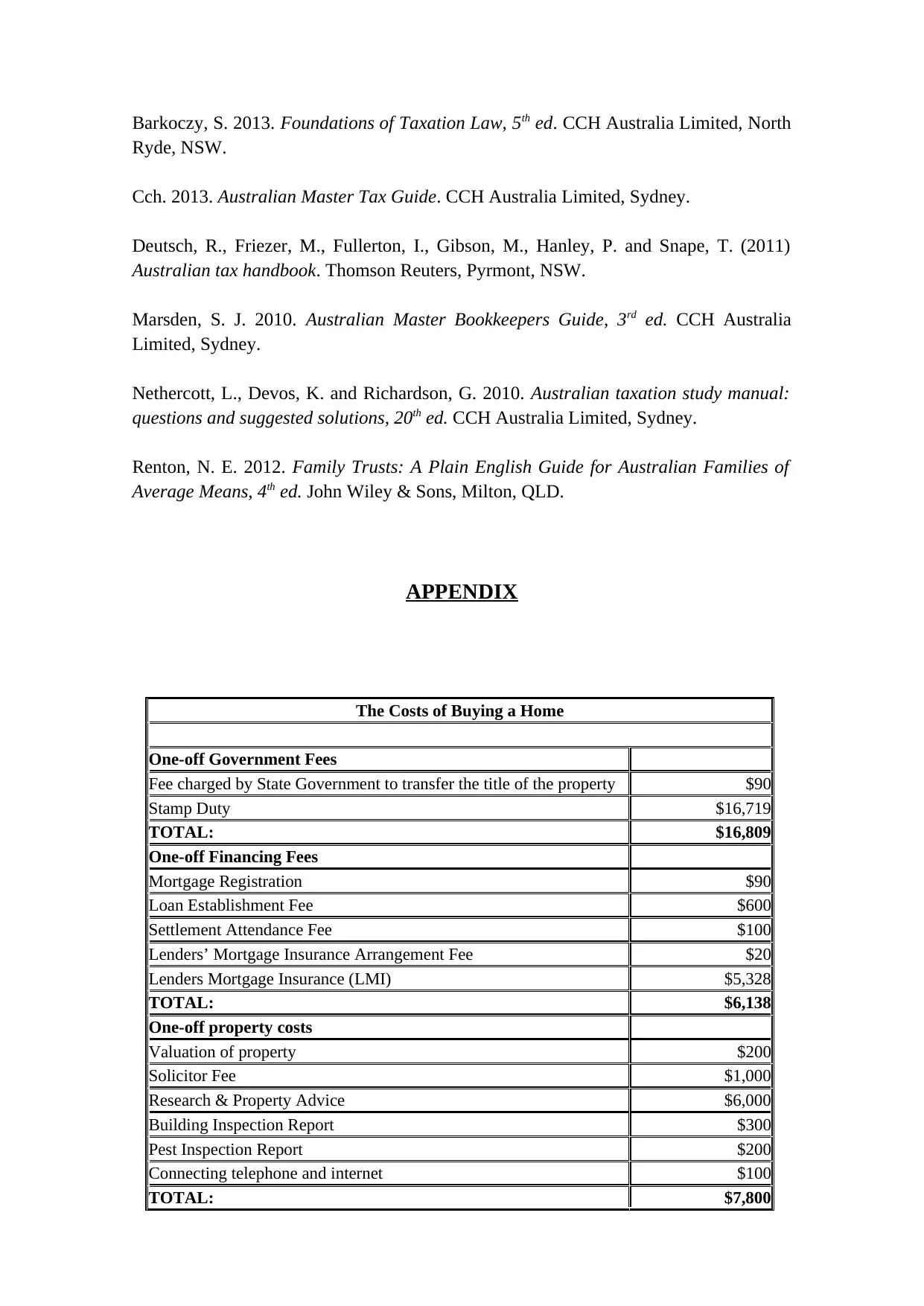
Barkoczy, S. 2013. Foundations of Taxation Law, 5th ed. CCH Australia Limited, North
Ryde, NSW.
Cch. 2013. Australian Master Tax Guide. CCH Australia Limited, Sydney.
Deutsch, R., Friezer, M., Fullerton, I., Gibson, M., Hanley, P. and Snape, T. (2011)
Australian tax handbook. Thomson Reuters, Pyrmont, NSW.
Marsden, S. J. 2010. Australian Master Bookkeepers Guide, 3rd ed. CCH Australia
Limited, Sydney.
Nethercott, L., Devos, K. and Richardson, G. 2010. Australian taxation study manual:
questions and suggested solutions, 20th ed. CCH Australia Limited, Sydney.
Renton, N. E. 2012. Family Trusts: A Plain English Guide for Australian Families of
Average Means, 4th ed. John Wiley & Sons, Milton, QLD.
APPENDIX
The Costs of Buying a Home
One-off Government Fees
Fee charged by State Government to transfer the title of the property $90
Stamp Duty $16,719
TOTAL: $16,809
One-off Financing Fees
Mortgage Registration $90
Loan Establishment Fee $600
Settlement Attendance Fee $100
Lenders’ Mortgage Insurance Arrangement Fee $20
Lenders Mortgage Insurance (LMI) $5,328
TOTAL: $6,138
One-off property costs
Valuation of property $200
Solicitor Fee $1,000
Research & Property Advice $6,000
Building Inspection Report $300
Pest Inspection Report $200
Connecting telephone and internet $100
TOTAL: $7,800
Ryde, NSW.
Cch. 2013. Australian Master Tax Guide. CCH Australia Limited, Sydney.
Deutsch, R., Friezer, M., Fullerton, I., Gibson, M., Hanley, P. and Snape, T. (2011)
Australian tax handbook. Thomson Reuters, Pyrmont, NSW.
Marsden, S. J. 2010. Australian Master Bookkeepers Guide, 3rd ed. CCH Australia
Limited, Sydney.
Nethercott, L., Devos, K. and Richardson, G. 2010. Australian taxation study manual:
questions and suggested solutions, 20th ed. CCH Australia Limited, Sydney.
Renton, N. E. 2012. Family Trusts: A Plain English Guide for Australian Families of
Average Means, 4th ed. John Wiley & Sons, Milton, QLD.
APPENDIX
The Costs of Buying a Home
One-off Government Fees
Fee charged by State Government to transfer the title of the property $90
Stamp Duty $16,719
TOTAL: $16,809
One-off Financing Fees
Mortgage Registration $90
Loan Establishment Fee $600
Settlement Attendance Fee $100
Lenders’ Mortgage Insurance Arrangement Fee $20
Lenders Mortgage Insurance (LMI) $5,328
TOTAL: $6,138
One-off property costs
Valuation of property $200
Solicitor Fee $1,000
Research & Property Advice $6,000
Building Inspection Report $300
Pest Inspection Report $200
Connecting telephone and internet $100
TOTAL: $7,800
1 out of 5
Related Documents
Your All-in-One AI-Powered Toolkit for Academic Success.
+13062052269
info@desklib.com
Available 24*7 on WhatsApp / Email
![[object Object]](/_next/static/media/star-bottom.7253800d.svg)
Unlock your academic potential
Copyright © 2020–2025 A2Z Services. All Rights Reserved. Developed and managed by ZUCOL.





